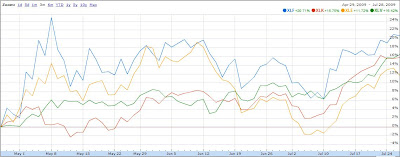Another day in the books, but there still hasn’t been too much selling pressure, with the S&P 500 down about a quarter of one percent. As I recently stated on my blog, I think there is a sell off ahead, or at least that is what the Volatility Index (VIX) is telling me.
Yesterday I chose to analyze 20 stocks from the NASDAQ (which is the index which has gained the most over the past 3 months), today I will perform the same analysis but by sector. If we do get a sell off I believe the stocks which will suffer the most are the financials, as they have had the best gains over the past 3 months. The chart below shows four major SPDR sector ETF’s: Financial, Health Care, Technology, and Energy (click image to enlarge).
 As you can see the Financials have outperformed the other three sectors.
As you can see the Financials have outperformed the other three sectors.
The Volatility Index rose again Monday by 3.01%, which again is an indicator to me that many are betting on a short term correction or sell off ahead. To reiterate a previous yet again: with all the cash on the sidelines (getting dirt cheap returns), this market could keep rallying with better than estimated earnings reports, and outlooks of an improving economy, however it never hurt anyone to take profits and protect on the downside a bit.
For this analysis I have gathered a list of the top twenty financial stocks (by market cap) from the S&P 500 index. I will outline an option idea on each stock which will provide a return (if the market keeps rallying and the stock is assigned at expiration), as well as downside protection on the stock (in case the market happens to sell off). Therefore to understand this post, you’ll need a general understanding of stock options. To learn more about options and, how options can help protect your portfolio, and allow you to speculate with less money up front; check out my book here.
All data as of market close Tuesday July 28, 2009.
The stocks are in order from greatest to least market cap. The first stock in the table below is JP Morgan (JPM) to understand how to read the table I’ll give a worded example using JPM. The example assumes the stock was being purchased and immediately written out for the August options expiration.
Purchase JP Morgan (JPM) stock, and sell the August 39 strike call option. The premium received from the call option would give a downside protection of 2.49%. If the stock is assigned at options expiration on August 22, 2009 the total return from this position would be 4.91%. The current options market is factoring in a 41.2% probability JP Morgan will be at or above 39 a share by the August options expiration.
| Company | Symbol | Strike | Return % | Protection % | Probability % |
| JPMorgan Chase & Co. | JPM | 39 | 4.91 | 2.49 | 41.2 |
| Bank of America Corporation | BAC | 14 | 7.72 | 2.77 | 36.7 |
| Wells Fargo & Company | WFC | 25 | 5.22 | 3.26 | 43.3 |
| Goldman Sachs Group, Inc. | GS | 165 | 4.78 | 2.01 | 37.7 |
| U.S. Bancorp | USB | 20 | 3.61 | 3.36 | 50.6 |
| Morgan Stanley | MS | 28 | 5.1 | 3.03 | 43.7 |
| American Express Company | AXP | 29 | 7.41 | 2.64 | 35.7 |
| The Bank of New York Mellon Corporation | BK | 28 | 6.66 | 1.94 | 32.1 |
| MetLife, Inc. | MET | 34 | 6.53 | 3.34 | 41.6 |
| The Travelers Companies, Inc. | TRV | 45 | 5.42 | 1.61 | 32.6 |
| State Street Corporation | STT | 50 | 7.03 | 2.14 | 33.7 |
| The Charles Schwab Corporation | SCHW | 17 | 3.47 | 3.41 | 50.6 |
| Franklin Resources, Inc. | BEN | 80 | 0.77 | 1.43 | 27.8 |
| Prudential Financial, Inc. | PRU | 44 | 7.74 | 4.91 | 45.7 |
| CME Group Inc. | CME | 280 | 7.56 | 2.51 | 35.1 |
| AFLAC Incorporated | AFL | 38 | 6.91 | 3.09 | 39.1 |
| PNC Financial Services | PNC | 37.5 | 6.16 | 3.42 | 43 |
| Citigroup Inc. | C | 3 | 7.41 | 6.4 | 51.4 |
| The Chubb Corporation | CB | 45 | 2.41 | 2.77 | 51.8 |
| BB&T Corporation | BBT | 23 | 7.01 | 2.28 | 34.4 |
All of these options expire on August 22; therefore the last trading day is Friday, August 21, 2009.
These are just examples and are not recommendations to buy or sell any security; if you’re more bullish/bearish, you’ll want to adjust the strike price and expiration accordingly.
This strategy will give protection if the market sells off, as well as provide a return if the market continues to rally. If the stock is not assigned, this strategy is a great way to create additional income for your portfolio. The reason option volumes have surged in the last 5 years is because they are a great way to hedge your portfolio as well as create income off of your shares (see chart here). Keep in mind when using this strategy it is essential that broker commissions are low enough to profit from the position.



